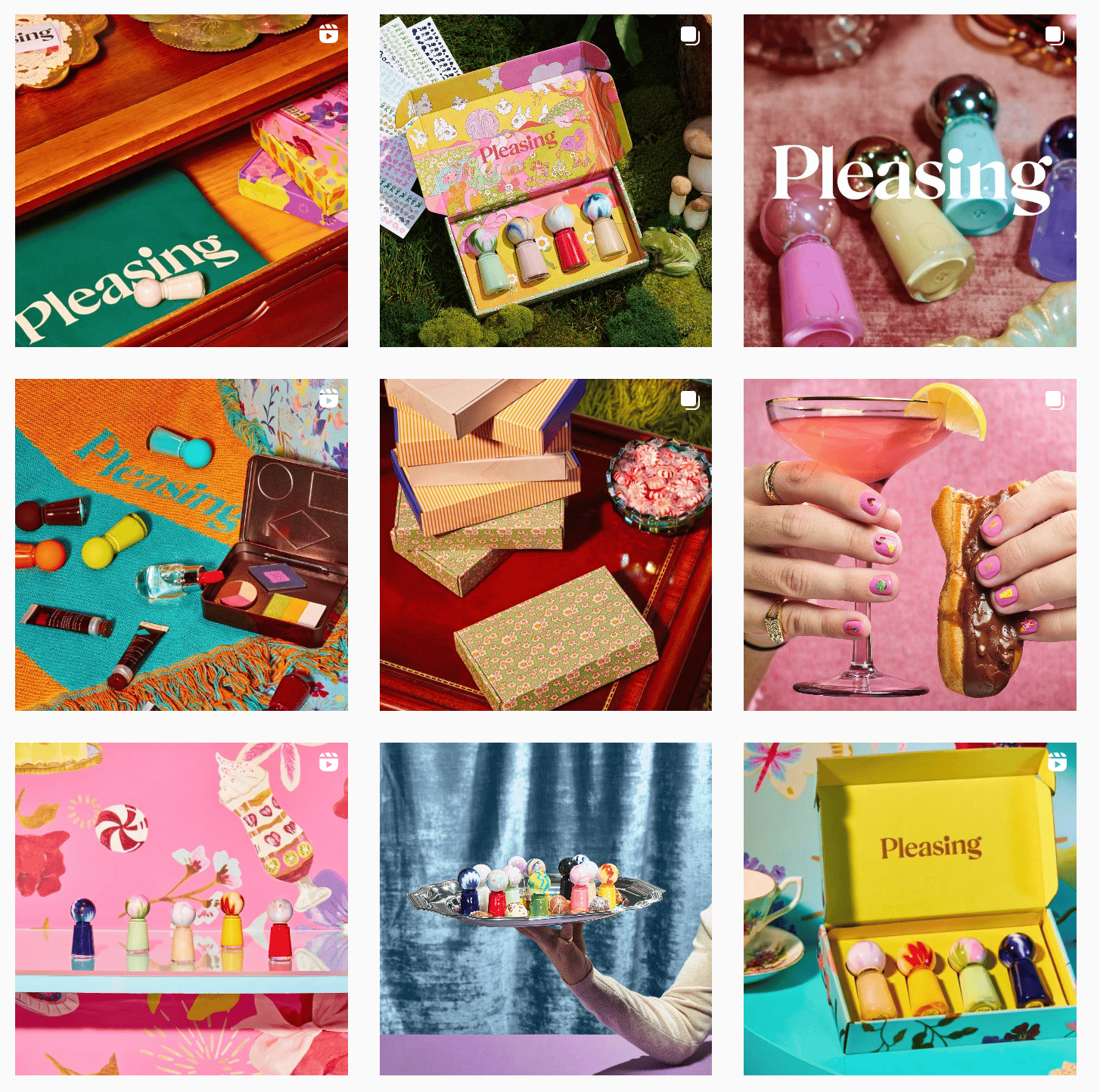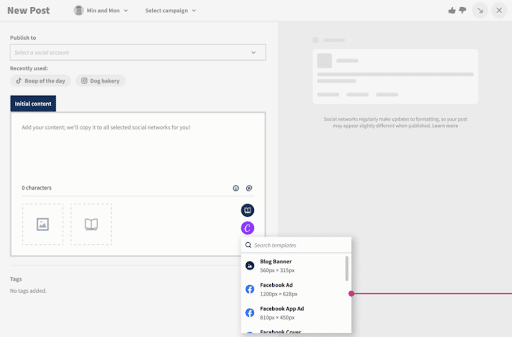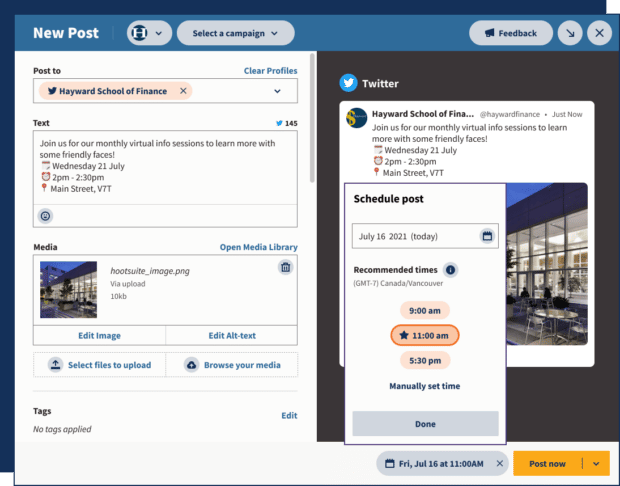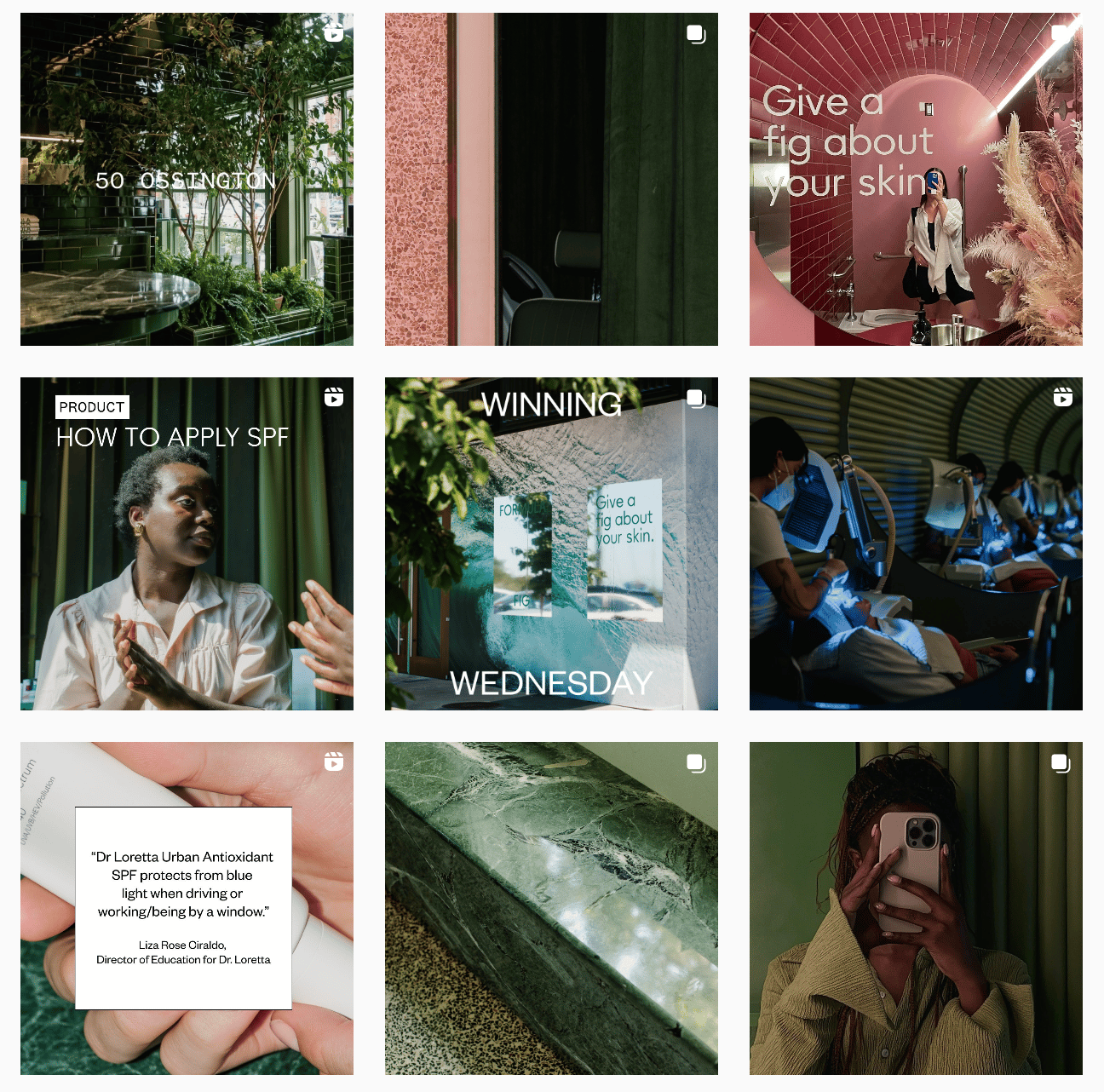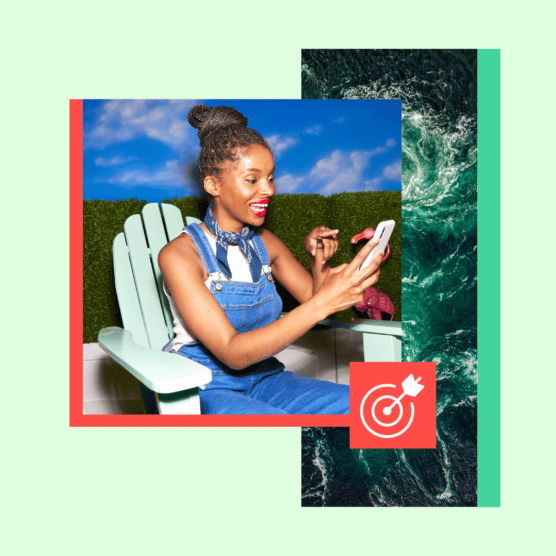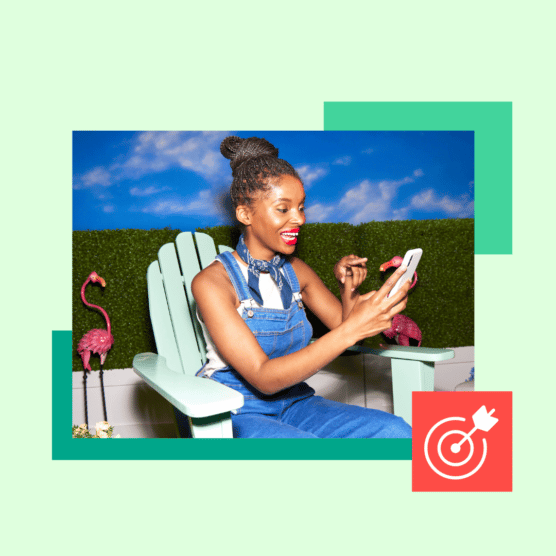Much like the common crow is attracted to shiny things, social media users love some good visual content.
Typically, our sense of sight is the first thing that’s engaged when experiencing a post on social media. And with so much content out there, it’s important for brands to stand out visually. Keep reading to find out how to create a smart visual content strategy for social media.
Bonus: Get the always-up-to-date social media image size cheat sheet. The free resource includes recommended photo dimensions for every type of image on every major network.
Visual content is any type of online content that is image-based. It’s content with a visual element — not just text-based, it’s a treat for the eyes, too. For example, a classic 280-character Tweet isn’t visual, but a Tweet with a photo attached is.
Types of visual content
- Photos
- Videos
- Carousel posts (multiple photos or videos)
- GIFs
- Illustrations
- Infographics
- Animations
- Memes
Videos and photos have proven to be more engaging than purely text-based posts across nearly all internet platforms. LinkedIn posts with images have a 98% higher comment rate on average, and tweets that include visual content are three times more likely to get engagement.
On Instagram, carousel posts have the highest engagement rate. According to this 2022 Statista data, the average engagement rate for any post on an Instagram business page is 1.94%. But carousel posts have an engagement rate of 3.15% (what can we say, the people love to swipe left).
It’s these kinds of stats that lead American marketers to say videos are most valuable for social media marketing. In a 2021 Statista survey, 54% of marketers said that videos are valuable for marketing goals on social media—it was the most common type of content named.
And it’s not just marketers that are noticing the value of visual content. Consumers know they want to see content in the form of photos and videos. A 2021 Swedish study (also conducted by Statista) found that when it comes to brands using social media, 47% of adults like to see content in the form of images. 35% said they like to see brand content in video form.
Everything you need to make engaging content. AI support for captions, an AI hashtag generator, and access to Canva in Hootsuite.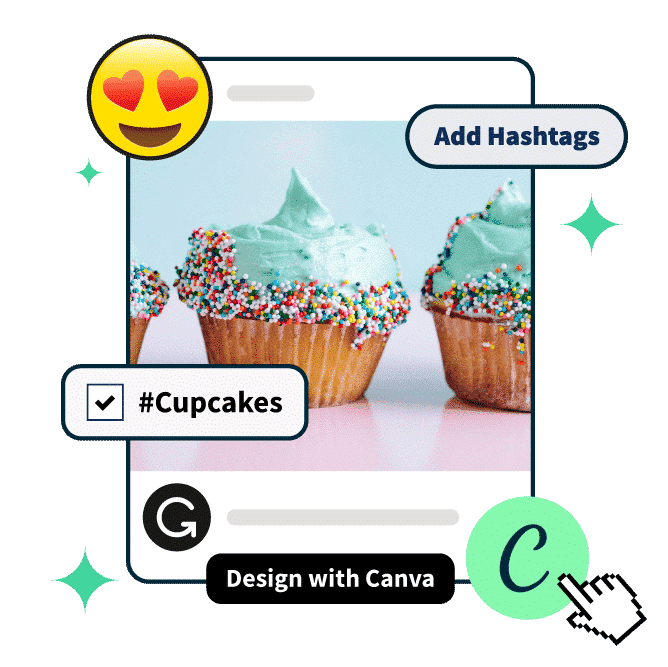
1. Establish a colour palette for your brand
Deciding (and sticking to) a certain colour palette or mood for your brand doesn’t just make your feed look beautiful: it also means your posts are instantly recognizable to your followers. Incorporate visual content into your social media style guide, and establish recognizable, eye-catching visual content from the start.
For example, viral nail polish brand Pleasing has a very—well, pleasing colour palette. The company’s posts are bright, bold and unique: they stand out from the crowd.
Source: Instagram
2. Choose eye-catching thumbnails for videos
When you’re posting videos on social media, the thumbnail (or the “cover image” that the platform will use to display your content) will often automatically be the first frame of that video. But the first frame of your video might not be the most exciting—or representative—image.
Manually choose a thumbnail when you’re posting videos (on IG Reels, TikTok, Youtube, etc.) and select an image that you think is most visually appealing, or communicates the most information.
The thumbnail images for this bakery’s Instagram reels are super Insta-worthy, and they make the brand’s most iconic item (the cinnamon bun) the star of the show. Some of the thumbnails even include text that gives the viewer a sneak peek of what the reel is about—for example, “Peach cinnamon buns giveaway.”
Source: Instagram
3. Incorporate text into your visual content…
Even if you work in a primarily text-based industry, you can still use visual content in marketing. Magazines have really nailed this incorporation of text: the main goal is to showcase the story (text-based) but the publication will use visual means to promote said story.
For example, this Teen Vogue story is mostly text, not images, but the article still appears on Teen Vogue’s Instagram in the form of a high-quality photo with text laid over it. This inclusion of text directly on the image makes the image’s purpose crystal clear, and it also makes the image very sharable (it can easily be added to followers’ IG stories).
4. …but don’t use too much text
While text can be a great tool for communicating information, it’s not easy on the eyes. In fact, too much text can be visually overwhelming for viewers. Less is more when it comes to adding text to your visual content.
This New York Times post is a fabulous example of careful text integration. The first image simply includes the story headline, and what follows is a mindful mix of visual content: there’s photos and videos, plus photos with snippets of text included. It’s an engaging, dynamic piece of visual content that inspires viewers to dig deeper (in this case, read the full story on the NYT website).

5. Use high-quality photos and videos
Duh, right? Visual content is first and foremost visually engaging, so you’ll want to make sure that you’re not posting blurry infographics or out-of-focus photos (unless that’s part of your brand, of course).
High-quality photos and videos are nice to look at, and they also help showcase your brand—and in some cases, the impact or effect of your brand. This high-quality photo post from Huda Beauty really shows off how well one of their mattifying products works.
If you don’t have the resources to take high-quality photos of your own, check out stock image websites and build visual content using your favourites.
6. Understand image copyright
Sourcing relevant images isn’t always easy—especially when it comes to understanding copyright. But it’s important, especially since there are serious consequences for misuse.
Read all the fine print when using stock photos, templates, and illustrations. If anything is unclear, inquire with the image owner or site for more detail.
The same goes for licensing and contracting. When drawing up contracts with artists, it should be clear where you intend to use creative, who owns the rights to it, etc.
When it’s called for (which is often), be sure to give credit where credit is due. That’s also true if you plan to repost or share user-generated content. Some companies, like Agoda, even use contract agreements in these contexts, too.
Disney World’s official Instagram often posts user-generated content, with the original poster credited in the caption.
7. Add your logo (where appropriate)
If you plan your visuals to be shared, it may be a good idea to include a logo.
Pinterest is a perfect example. Anything pinned has the potential of being repinned, and without a logo, it can be easy to forget where it came from. Plus, according to Pinterest, pins with subtle branding tend to perform better than those without. Ikea includes their logo in nearly all of their pins (many of which are reshared tens of thousands of times).
https://www.pinterest.ca/pin/252834966572453484/
Good branding is noticeable but not obtrusive. Typically that means putting a small logo in a corner or the outer frame of the visual. If the colour of your logo clashes or makes the visual too busy, opt for a greyscale or neutral version.
National Geographic’s logo is a good example of subtle branding–the yellow rectangle is present in almost all of their posts across all platforms.
https://www.facebook.com/photo.php?fbid=681624516668315&set=pb.100044623170418.-2207520000.&type=3
8. Size images to spec
One of the biggest crimes you can commit when sharing visuals on social media is using the wrong size.
Images with the wrong aspect ratio or low resolutions can be stretched, cropped, and crunched out of proportion—all of which reflects poorly on your brand.
Every platform has its own specifications and you should tailor your content accordingly. We’ve assembled a social media image size guide to help you.
Always aim for the highest image quality. That includes pixels and resolution.
And don’t ignore aspect ratio. Why? Some platforms auto-crop image previews based on aspect ratio. So if yours is different, you could end up with an unfortunate crop, or have important info left out.
9. Start videos with a hook
When making Instagram Reels, TikToks and even video content for Facebook, Linkedin and Youtube, ensure that the first few seconds are engaging and entertaining (if they’re not, your audience will likely scroll on by).
For examples of starting off visual content with a hook, look at culinary content creators—they’re excellent at drawing you in with the final product, so you’ll stay to learn the entire recipe. This tofu recipe starts with the creator drawing a knife across (impressively) crispy tofu, immediately piquing curiosity. The sound of the knife and the creator’s bold opening line (“I hate tofu”) only adds to the engaging visual.
@fitgreenmind Yes, tofu can taste good! 🌱 #veganlunch #vegandinner #tofu #tofurecipe #easyrecipes
10. Take advantage of free tools and resources
It’s almost always best to hire a photographer or graphic designer to do custom content creation for your brand.
But if your budget is tight, or you’re in need of a few extra tools, there are countless resources available—and many of them are free.
Here are some of the best design resources and tools:
- 38 resources for free stock photos
- 24 of the best Instagram apps for editing, design, and more
- 72 free and customizable Instagram Story templates
- 5 free and easy-to-use Lightroom Instagram presets
- 9 inclusive design tools and resources
- 5 free templates for Facebook cover photos
- 14 social media content creation tools
Some social media management platforms have photo and video editing elements incorporated right into their dashboards… for example, Hootsuite has Canva.
No more switching tabs, digging through your “Downloads” folder, and reuploading files — you can access Canva’s endless template library and create beautiful and effective visuals from start to finish without leaving Hootsuite Composer.
To use Canva in Hootsuite:
1. Log in to your Hootsuite account and head to Composer.
2. Click on the purple Canva icon in the bottom right corner of the content editor.
3. Select the type of visual you want to create. You can pick a network-optimized size from the drop-down list or start a new custom design.
4. When you make your selection, a login pop-up window will open. Sign in using your Canva credentials or follow the prompts to start a new Canva account. (In case you were wondering — yes, this feature does work with free Canva accounts!)
5. Design your image in the Canva editor.
6. When you’re done editing, click Add to post in the top right corner. The image will automatically be uploaded to the social post you’re building in Composer.
Learn more about using Canva in Hootsuite.
11. Include alt-text descriptions
Not everyone experiences visual content the same way.
When producing creative for social media, make it accessible for as many people and contexts as possible. Accessible content allows you to reach a broad audience and possibly edge out non-inclusive competitors in the process.
More importantly, it helps you earn respect and loyalty from your followers (and followers-to-be).
Accessible visual content on social media can include:
- Alt-text descriptions. Alt-text allows visually impaired people to better comprehend images. Facebook, Twitter, LinkedIn and Instagram now provide fields for alt-text image descriptions. Here are some tips for writing descriptive alt-text, along with specific guides for Facebook alt text and Instagram alt text.
- Subtitles. All social videos should include captions. Not only are they crucial for hearing impaired viewers, they help in sound-off environments as well. Language learners also benefit from subtitles.
- Descriptive transcripts. Unlike captions, these transcripts describe the important sights and sounds that aren’t spoken or obvious. Descriptive audio and live described video are other options.
While TikTok automatically shows the sound that each video uses, this content creator uses captions to show exactly which part of the song they are referencing—ensuring that everyone is in on the joke.
@realchelseabearIf I had a dollar for every dirty look I’ve gotten 🤦🏻♀️ #CerebralPalsy #Disability♬ original sound – ⭐️Helene⭐️
12. Pay attention to trends
It’s important to stay up-to-date on what’s trending on every platform. This doesn’t just help you stay in touch with your audience; trends are a great source of inspiration if you find your creativity running dry.
Trends aren’t just visual, of course, but some of them have a visual element that is instantly recognizable—for example, the Horace dancing trend on TikTok.
@sarahdame91 Dc : horace 😍🥰 #dance
You can pick up on trends from simply scrolling through your socials, or check out one of the lists we’ve put together:
- 11 Important social media trends for 2023
- 12 Instagram trends to watch
- 14 TikTok trends to watch
- 10 Facebook trends to watch
13. Schedule your visual content
You can craft the most engaging, thought-provoking, sharable visual content in the universe… but if people don’t actually see it, it won’t matter.
Because of the sheer volume of social media users (globally, more than 4.62 billion people use social media), you’re always going to get at least a few viewers on your post—however, you can greatly increase your chances of your content taking off by posting when your audience is actually using the platform.
We’ve rounded up the best times to post on Facebook, Instagram, Twitter, TikTok and Linkedin, so you can set yourself up for success. Set it and forget it (crock pot style) by using Hootsuite’s planner and scheduling tool to make sure your content goes live at the best time.
14. Be mindful of representation
Do the people in your visuals reflect the diversity of your audience? Are you reinforcing gender or racial stereotypes with your images? Do you promote body positivity? These are a few of the questions you should be asking when making visual content for social media.
Doing so is not just socially responsible, it’s smart. It’s much easier for someone to imagine themselves using a product or service if they see someone that looks like them doing it. Look at your audience analytics, or the demographics of your desired market, and factor them into your creative process.
Representation should be about more than just optics. If you have the means to diversify your team, do it. Hire women, queer people and creators of color. Bring as many perspectives to the table as you can.
At the very least, try to get feedback from as many voices as possible before sending your content off into the world.
Lizzo’s brand Yitty is an excellent example—the brand’s visual content represents her target audience.
https://www.facebook.com/YITTYofficial/posts/pfbid02LTXLbwazQCzv2cMwLwd7aNH8Mx5ZrzfLfQK6dojRh7h2v8jSYtqkTuHrjUmXKuNMl
9 visual content examples from brands that get it right
1. Formula Fig’s consistent colour palette
Picking a colour palette and sticking to it pays off—just ask this skincare brand’s super-aesthetic feed that perfectly represents their visual identity.
Source: Instagram
2. Instagram’s eye-catching visuals
Who better to trust with visuals than a visual artist? Instagram’s collab with the Trevor Project and artist @beeillustrates is a beautiful example of how to share (very important) information.
3. Ocin’s sharable event images
Speaking of sharing: swimwear brand Ocin makes easy-to-read, stylish graphics to announce events. With all the info on a single image, it makes the event very easy to share to a story or send to a friend.
4. JessaKae’s inclusive videos
When it comes to representation in visuals, JessaKae nails it. Many of the brand’s videos showcase exactly how inclusive their sizing is, using models that are representative of their diverse consumer base.
@jessakae One dress, 4 colors, available in 12 sizes. Our Wendy dress is a crowd favorite ⭐️ #inclusivefashion #sizeinclusive #midsizefashion #plussizeedition #boutique
5. Bailey Nelson’s simple animations
Eyewear brand Bailey Nelson takes “less is more” to heart when it comes to text in their visuals, but the animation keeps it interesting.
6. Flax Home’s limited text
Here’s another example of how limited text can be effective: Flax Home’s giveaway announcement. The majority of the information is in the post’s caption, leaving the visual itself very clean-looking.
https://www.facebook.com/shopflaxhome/photos/1293150261443658
7. Sticky Lollies’ video hooks
This candy company engages viewers from the start with visually-appealing clips in the first few seconds of every video. They also appeal to a sense of mystery—audiences will stick around to see what the final product is.
@stickyaustralia Can you see our design?
8. Chanel’s creative carousels
If you have an image that isn’t quite the right size for the platform, there’s creative ways to get around it. For example, you can rasterbate (cut up) the image and post it as a carousel, which results in the cool sliding experience below.
9. Dylan Sprouse’s bizarre grid
Want to see one of Dylan Sprouse’s old Instagram posts? Too bad, you can’t: the celeb has adopted a very strange visual branding on his IG profile by posting 8 doodled images that, when combined, look like a living room, leaving only one spot (the top left) for a photo… that’s where the TV screen is. So every time he posts a new photo, he deletes (or archives, it’s impossible to tell) the previous one.

Source: Instagram
It’s a weird example to leave you with, but it certainly proves that when it comes to visual content, creativity goes a long way. Take a risk or two.
Save time managing your social media presence with Hootsuite. From a single dashboard you can publish and schedule posts, find relevant conversions, engage the audience, measure results, and more. Try it free today.
Boost engagement and save time with an AI writer, hashtag generator, and Canva in Hootsuite.
Free 30-Day Trial
